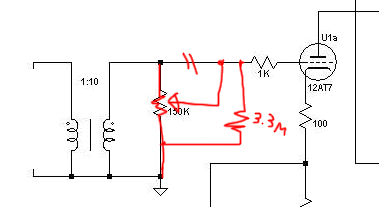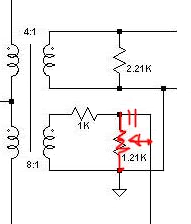You are using an out of date browser. It may not display this or other websites correctly.
You should upgrade or use an alternative browser.
You should upgrade or use an alternative browser.
Simple Pre
- Thread starter analag
- Start date
Help Support GroupDIY Audio Forum:
This site may earn a commission from merchant affiliate
links, including eBay, Amazon, and others.
rafafredd
Well-known member
very interesting design. Never seen something like this for a tube mic pre.
No gain / level control? Maybe making that 1.21k resistor at the output a pot for variable feedback, and also the 150k resistor after the input transformer for variable input level???
That would make it very versatile, with input and gain control.


No gain / level control? Maybe making that 1.21k resistor at the output a pot for variable feedback, and also the 150k resistor after the input transformer for variable input level???
That would make it very versatile, with input and gain control.


skipwave
Well-known member
The feedback winding seems like a lot trouble to go to when you have a balanced input. Does this realize some performance advantage over driving the U1B grid from the low side of the input transformer?
I can see how it would perform differently with the feedback instead of the simple fully-balanced approach. Very interesting.
I can see how it would perform differently with the feedback instead of the simple fully-balanced approach. Very interesting.
[quote author="emrr"]So, why the voltage divider on the feedback winding rather than the correct ratio? Or, does that simply represent your current state of experimentation within your models abilities?[/quote]
This is an idea, I have been playing with. I believe the correct ratio should be arrived at through experimentation.
This is a simplified version of the design...I would put a pot right after the transformer as rafafredd suggests. I prefer that approach over the variable feedback setup that is more common place in tube pre designs.
I have developed a liking for the sound of tubes and transformers only with no caps in the signal path. I guess my journey into the Fairchild topology rubbed off.
This is an idea, I have been playing with. I believe the correct ratio should be arrived at through experimentation.
This is a simplified version of the design...I would put a pot right after the transformer as rafafredd suggests. I prefer that approach over the variable feedback setup that is more common place in tube pre designs.
I have developed a liking for the sound of tubes and transformers only with no caps in the signal path. I guess my journey into the Fairchild topology rubbed off.
Kingston
Well-known member
[quote author="analag"]I have developed a liking for the sound of tubes and transformers only with no caps in the signal path.[/quote]
This is very interesting. I have never heard such an amp in action. I did see your earlier capless tube pre design few months back and forgot to ask, how is the sound different to the more conventional large cap designs? Is it remarkably different and in what way? I mean besides the fact such exotic transformers will have a large impact on the sound (which should be interesting in itself).
Michael
This is very interesting. I have never heard such an amp in action. I did see your earlier capless tube pre design few months back and forgot to ask, how is the sound different to the more conventional large cap designs? Is it remarkably different and in what way? I mean besides the fact such exotic transformers will have a large impact on the sound (which should be interesting in itself).
Michael
Without the cap, the sweet spot that the tube gear is generally known for becomes much wider. (Providing you have good transformers)
I also prefer the sound of M6 over nickel core, especially when slammed hard, something special happens that nickel just can't do.
I also prefer the sound of M6 over nickel core, especially when slammed hard, something special happens that nickel just can't do.
pstamler
Well-known member
Turning the 150k transformer loading resistor into a pot plays hob with the signal-to-noise ratio. Worst case, the s/n gets about 9dB worse.
Peace,
Paul
Peace,
Paul
[quote author="analag"][quote author="emrr"]So, why the voltage divider on the feedback winding rather than the correct ratio? Or, does that simply represent your current state of experimentation within your models abilities?[/quote]
This is an idea, I have been playing with. I believe the correct ratio should be arrived at through experimentation.
This is a simplified version of the design...I would put a pot right after the transformer as rafafredd suggests. I prefer that approach over the variable feedback setup that is more common place in tube pre designs.
[/quote]
From hearing a good many older circuits, I've had the impression of preferring feedback windings like this over networks between the iron.
I've generally not preferred circuits that followed the input transformer with a pot (usually only seen in older line amps, and now modern preamps), but rather ones that use some sort of interstage pot.
I also like the concept seen in some older Western Electric amps of strapping gain stages in or out depending on need. I've done this in a few four stage 90db type Gates Radio amps, which really helps S/N and overload points when addressed with wildly different levels day to day.
This is an idea, I have been playing with. I believe the correct ratio should be arrived at through experimentation.
This is a simplified version of the design...I would put a pot right after the transformer as rafafredd suggests. I prefer that approach over the variable feedback setup that is more common place in tube pre designs.
[/quote]
From hearing a good many older circuits, I've had the impression of preferring feedback windings like this over networks between the iron.
I've generally not preferred circuits that followed the input transformer with a pot (usually only seen in older line amps, and now modern preamps), but rather ones that use some sort of interstage pot.
I also like the concept seen in some older Western Electric amps of strapping gain stages in or out depending on need. I've done this in a few four stage 90db type Gates Radio amps, which really helps S/N and overload points when addressed with wildly different levels day to day.
Larrchild
Well-known member
Analag, remember my WE-407 mic pre with tertiary feedback winding?
All went well until the phase shift of the FB winding created instability.
That's the only caveat to doing this.
A good transformer!
All went well until the phase shift of the FB winding created instability.
That's the only caveat to doing this.
A good transformer!
Larrchild
Well-known member
So the conundrum was that a nickel core would allow less turns and hence less phase shift.
But I wanted the M-6 sound.
So thats the design problem.
But I wanted the M-6 sound.
So thats the design problem.
Off topic a bit but some of what was posted is why I now try to work with the stock china transformer alloy in some of the china microphones.
1v RMS into 1k load for 1 mw. microphone outputs and inputs to preamps can be at a power level that can make it hard to pick what alloy etc to use.
1v RMS into 1k load for 1 mw. microphone outputs and inputs to preamps can be at a power level that can make it hard to pick what alloy etc to use.
[quote author="Larrchild"]So the conundrum was that a nickel core would allow less turns and hence less phase shift.
But I wanted the M-6 sound.
So thats the design problem.[/quote]
In my case I was using C-Core M-4 steel and oversized too for less turns. It's actually one of the left over C-Core I might use for this design. I also have some ideas for the winding layout, I think the location of the tertiary winding is very important. I might end up winding it a few times to get it right.
I definitely prefer the sound of steel over nickel whether it's input or out.
I recently built the Jensen Twin Servo pre using my own discrete opamp and M-6 input and output transformer, while it is not as musical sounding as my tube pre's, it is bigger and more clinically precise than anything I have in my arsenal.
Two days ago I completed a 1176 comp which I built out of (1) curiousity and (2) boredom, I used M-6 steel for input and output with the input pot after the input trannie so I could slam the steel without overdriving the gain stage. It sweet me bredah.
But I wanted the M-6 sound.
So thats the design problem.[/quote]
In my case I was using C-Core M-4 steel and oversized too for less turns. It's actually one of the left over C-Core I might use for this design. I also have some ideas for the winding layout, I think the location of the tertiary winding is very important. I might end up winding it a few times to get it right.
I definitely prefer the sound of steel over nickel whether it's input or out.
I recently built the Jensen Twin Servo pre using my own discrete opamp and M-6 input and output transformer, while it is not as musical sounding as my tube pre's, it is bigger and more clinically precise than anything I have in my arsenal.
Two days ago I completed a 1176 comp which I built out of (1) curiousity and (2) boredom, I used M-6 steel for input and output with the input pot after the input trannie so I could slam the steel without overdriving the gain stage. It sweet me bredah.
Similar threads
- Replies
- 0
- Views
- 448
- Replies
- 3
- Views
- 149



